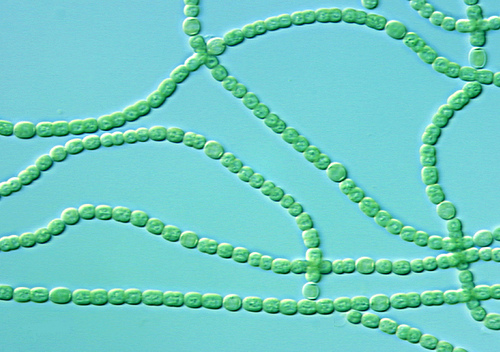Despite their miniscule size, cyanobacteria play significant roles in the global carbon and nitrogen cycles. Researchers are also looking at utilizing them for biofuel and biotechnology applications.
In an effort to learn more about the diverse strains in this phylum, DOE Joint Genome Institute scientist Cheryl Kerfeldis leading an effort called CyanoGEBAto increase the number of available cyanobacterial genomes for study. The project’s name is a nod to the Genomic Encyclopedia of Bacteria and Archaea (GEBA) project that pioneered sequencinggenomes from under-represented branches in the Tree of Life.

Chains of cyanobacteria. (Image courtesy of James Golden, UC San Diego)
Creative Commons Attribution-Noncommercial-Share Alike 2.0 Generic License by Argonne National Laboratory
In an article published online December 31, 2012 in the Proceedings of the National Academy of Sciences, Kerfeld and her colleagues reported on a comparative analysis of several dozen CyanoGEBA genomes. (Study first author Patrick Shih spoke briefly about the CyanoGEBA project at the 2012 DOE JGI Genomics of Energy & Environment Meeting.) A total of 54 cyanobacterial genomes were sequenced; 29 complete genomes were assembled while the rest are in draft status. Their contributions have doubled the amount and diversity of the extant genomes.
“With the exponentially growing capacity for sequencing genomes it is becoming increasingly important to focus sequencing efforts so as to obtain a high-value return,” the team wrote. “The extensive phylogenetically based survey … demonstrates the benefits gained from a more balanced representation of sequenced genomes within a phylum.”
One of the questions the team hopes to answer through a continued increase of the phylogenetic diversity of cyanobacterial genomes is the identity of the closest relatives to the original lineage whose chloroplasts were engulfed in that first endosymbioticevent that resulted in the diverse range of photosynthetic organisms.